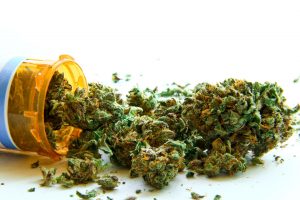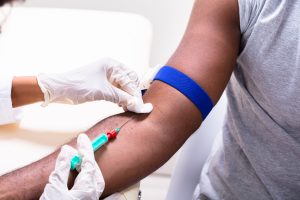Oklahoma Bar Journal
Impaired or Not, Medical Marijuana Patients Risk DUI Every Day
By Sabah Khalaf
 On any given day, an estimated 1 in 10 Oklahomans are breaking the law when they drive to work or run errands.1 The reason? They legally consumed medical marijuana within the last month.2 Under Oklahoma’s current DUI laws, they could be guilty of DUI even if they haven’t consumed marijuana that day or even that week.3
On any given day, an estimated 1 in 10 Oklahomans are breaking the law when they drive to work or run errands.1 The reason? They legally consumed medical marijuana within the last month.2 Under Oklahoma’s current DUI laws, they could be guilty of DUI even if they haven’t consumed marijuana that day or even that week.3
When Oklahoma voters passed SQ 788 and legalized medical marijuana in 2018, a paradox of legal consumption and illegal driving was created. This has led to hundreds of thousands of Oklahomans being at risk of arrest and conviction of a DUI when they are not actually impaired.
The personal impact of a DUI arrest can be financially, emotionally and socially devastating. “False positive” DUI arrests of people who are not impaired also do nothing to make our roads safer. At a time when our state is actively working toward criminal justice reform and the people have voted to legalize medical marijuana, we cannot ignore this gap between our DUI laws and reality.
ZERO TOLERANCE – PERIOD
Oklahoma law is quite clear: Driving with any registrable amount of marijuana in your system is illegal, whether it was legally prescribed or not.4While at first this might seem like a common-sense policy to make our roads safer, it leaves no room for major differences in how marijuana affects the body and how impairment is measured. Our no tolerance per se DUI laws passed in 2013 treat marijuana consumption by the federal standard. Since marijuana is a Schedule I drug and illegal federally, any trace amount of marijuana or its metabolites in bodily fluid is enough to trigger a DUI arrest, regardless of intoxication or impairment.5
MARIJUANA INTOXICATION CANNOT BE MEASURED LIKE ALCOHOL
We have an established system of measuring alcohol intoxication and a long history of scientific research to back it up. Generally speaking, alcohol in the breath or blood directly correlates to intoxication and impairment. For marijuana, there is no such evidence-based system and standard. The 2017 National Highway Traffic Safety Administration (NHTSA) report on marijuana driving safety concluded, “There are currently no evidence-based methods to detect marijuana-impaired driving.”6
Despite this, two approaches of detection are currently used in Oklahoma. The first – Standardized Field Sobriety Tests (SFST) – is also commonly given for determining alcohol impairment. They are not, however, validated for anything other than alcohol. In one illustrative example, officers in Colorado conducted SFST training on volunteers, some actively impaired by marijuana.7Officers demonstrated an inability to determine who was impaired based on SFSTs, failing to identify intoxicated people and falsely identifying some who were not intoxicated. An April 2021 National Institute of Justice (NIJ) study found similar results, noting, “One leg stand, walk and turn, and modified Romberg balance tests were not sensitive to cannabis intoxication for any of the study participants.”8 Despite the mounting evidence against their accuracy, officer recognition of drugged driving through SFSTs is still in widespread use across the country and Drug Recognition Expert (DRE) training continues.

© Andrey Popov | #292432202 | stock.adobe.com
Blood testing is the current “gold standard” for determining marijuana impairment, despite serious problems with the underlying science. In the same study, the NIJ notes, “THC Levels in study participants’ biofluids were not reliable indicators of marijuana intoxication,” and, “There is little evidence correlating a specific THC level with impaired driving.”9 To understand why, we can compare alcohol and marijuana and how they behave in the body. Alcohol is water soluble and metabolizes at a relatively steady rate.10 This means intoxication can be reliably measured in the hours after an arrest, but detectable traces of consumption (and therefore impairment) disappear after 12 to 24 hours.11 Practically, this means alcohol impairment can be measured at or soon after an arrest with reasonable accuracy, and a false positive won’t appear the next week. Put simply, drinking on Friday will not lead to a DUI arrest on Monday.
Marijuana interacts with the body in a completely different way. The main psychoactive ingredient in marijuana is Delta-9-tetrahydrocannabinol, commonly known as THC.12 Because THC is fat soluble, it remains in the body long after the psychoactive effects have worn off.13 In fact, THC can stay in the body for 30 days after consumption, long after impairment.14 The April 2021 NIJ report found that marijuana’s cognitive and psychomotor effects, those that indicate potential impairment, returned to baseline after four to eight hours.15 But in Oklahoma, THC presence in the blood is often used to convict, regardless of a prescription or actual intoxication. Smoking marijuana on Friday can lead to a DUI arrest on Monday, or next Monday or longer, even when there is no impairment.
Compounding the problem, blood THC levels vary widely based on a number of different factors compared with the more uniform reliability of BAC. Peak levels of THC can occur at low levels of impairment and vice versa.16 Regular marijuana users, such as medical patients, can have ongoing blood THC levels similar to the amount of someone who consumed marijuana recently.17Paradoxically, people who do not regularly consume marijuana can have no blood THC level despite being actively impaired.18Blood THC levels also peak within minutes of smoking and drop 80 to 90% from the peak level within 30 minutes.19 By the time a driver has been transported to the hospital for a blood draw or a search warrant is obtained, the THC level in the blood is relatively low.20 At this THC level, impairment is often indistinguishable from regular use. A 2017 NHTSA report summarized it best as “... the poor correlation of THC level in the blood or oral fluid with impairment precludes using THC blood or oral fluid levels as an indicator of driver impairment.”21
TWO SCENARIOS: THC IN THE BLOOD DOESN’T SIGNAL IMPAIRMENT
How might this impact individuals? Imagine two people, Bill and Susan. Bill goes out for a night of drinking on Friday and does not drive. On Monday night, he is stopped for a minor traffic violation and because his eyes are bloodshot, the officer suspects he has been drinking. Bill isn’t intoxicated, he’s just tired, and a breathalyzer and blood test back this up. He is not arrested because he is not impaired. Susan, on the other hand, is prescribed medical marijuana and consumes it on Friday. She does not drive while intoxicated. On Monday, she is stopped for a minor violation. Because of the smell of marijuana in her car and her bloodshot eyes, the officer concludes she is high. She’s also just tired and is legally transporting her prescribed medicine. However, because THC is present in her body, a blood test could be enough to arrest and convict her of DUI. She could still be arrested and convicted of this same DUI, based on the current per se laws, even if she had been stopped up to 30 days later and had not consumed marijuana in a whole month.
THC (SCHEDULE III) IS NOT MARIJUANA (SCHEDULE I)
While the lack of connection between THC and impairment is enough to invalidate it as a reliable measurement, there’s another problem with blood testing for THC: It’s not a Schedule I drug in Oklahoma. Oklahoma’s DUI statute says a person driving who “has any amount of a Schedule 1 chemical or controlled substance … or one of its metabolites or analogs in the person’s blood, saliva, or urine” is guilty of DUI.22Tetrahydrocannabinols are separately classified as Schedule III under Oklahoma law, meaning the mere presence of THC or its metabolites while driving is not illegal.24o put it another way, the blood test police are using to determine if someone is guilty of DUI tests for a substance that doesn’t qualify under the statute.
WHAT TO DO? THESE LAWS DON’T SERVE OUR STATE
Oklahoma’s DUI laws are woefully behind the available science and the reality of legal medical marijuana use. Multiple studies have shown there is no statistically significant connection between blood THC level and impairment or driver risk, THC in the body does not indicate marijuana use and THC levels are not correlated with impairment. Yet, we continue to use THC as the primary determinant of impairment. The Governors Highway Safety Association (GHSA) does not recommend per se DUI laws because there is little science to back up their use: “The [alcohol] DUI per se laws are justified because of the overwhelming scientific evidence that drivers are impaired when their BAC reaches the per se level. While many wish that per se limits could be justified similarly for drugs in general and marijuana in particular, they cannot (Compton, 2017; GAO, 2015).”24
As written, our current DUI laws with respect to marijuana do not promote safer driving nor are they fair to the more than 380,000 legal users of marijuana in Oklahoma. The law must change to better reflect our changed reality.
 ABOUT THE AUTHOR
ABOUT THE AUTHOR
Sabah Khalaf graduated from the TU College of Law in 2010 with honors and served as a Tulsa County assistant district attorney. His practice is hyper-focused on DUI defense, drug conspiracies and major crimes. He is the recipient of the Tulsa County Bar Association Outstanding Young Lawyer Award and the American Inns of Court Athens Sontag Award.
- Estimated based on active medical marijuana licenses compared with total state population (~9.6%).
- Generalization of use by medical marijuana patients.
- 47 O.S. §11-902 (OSCN 2021) (A)(3).
- Id.
- Id.
- Compton, R. Marijuana-Impaired Driving - A Report to Congress. (DOT HS 812 440). Washington, D.C.: National Highway Traffic Safety Administration at page 13 (July 2017).
- Ra’e Ellen Bichell, “Scientists Still Seek A Reliable DUI Test for Marijuana,” (July 30, 2017) www.npr.org/sections/health-shots/2017/07/30/523004450/scientists-still-seek-a-reliable-dui-test-for-marijuana.
- National Institute of Justice, "Field Sobriety Tests and THC Levels Unreliable Indicators of Marijuana Intoxication," April 5, 2021, nij.ojp.gov: https://nij.ojp.gov/topics/articles/field-sobriety-tests-and-thc-levels-unreliable-indicators-marijuana-intoxication.
- Id.
- Compton, R. Marijuana-Impaired Driving - A Report to Congress. (DOT HS 812 440). Washington, D.C.: National Highway Traffic Safety Administration at page 4 (July 2017).
- Scot Thomas, “How Long Does Alcohol Stay in Your System?” (April 6, 2021) https://americanaddictioncenters.org/alcoholism-treatment/how-long-in-system.
- Compton, R. Marijuana-Impaired Driving - A Report to Congress. (DOT HS 812 440). Washington, D.C.: National Highway Traffic Safety Administration at page 4 (July 2017).
- Id.
- Id.
- National Institute of Justice, "Field Sobriety Tests and THC Levels Unreliable Indicators of Marijuana Intoxication," April 5, 2021, nij.ojp.gov: https://nij.ojp.gov/topics/articles/field-sobriety-tests-and-thc-levels-unreliable-indicators-marijuana-intoxication.
- Compton, R. Marijuana-Impaired Driving - A Report to Congress. (DOT HS 812 440). Washington, D.C.: National Highway Traffic Safety Administration at page 4 (July 2017).
- Id at page 7.
- Nathalie A Desrosiers, Sarah K Himes, Karl B Scheidweiler, Marta Concheiro-Guisan, David A Gorelick, Marilyn A Huestis, “Phase I and II Cannabinoid Disposition in Blood and Plasma of Occasional and Frequent Smokers Following Controlled Smoked Cannabis,” Clinical Chemistry, Volume 60, Issue 4, April 1, 2014, pages 631–643, https://doi.org/10.1373/clinchem.2013.216507.
- Compton, R. Marijuana-Impaired Driving - A Report to Congress. (DOT HS 812 440). Washington, D.C.: National Highway Traffic Safety Administration at page 5 (July 2017).
- Id at page 6.
- Id at page 27.
- 47 O.S. §11-902 (OSCN 2021) (A)(3).
- 63 OK Stat §63-2-208 (2014).
- Governors Highway Safety Association, “Drug-Impaired Driving: Marijuana and Opioids Raise Critical Issues for States,” (May 2018) (page 32) https://docs.house.gov/meetings/IF/IF17/20180711/108525/HHRG-115-IF17-20180711-SD003.pdf.
Originally published in the Oklahoma Bar Journal – OBJ 92 Vol 8 (October 2021)

